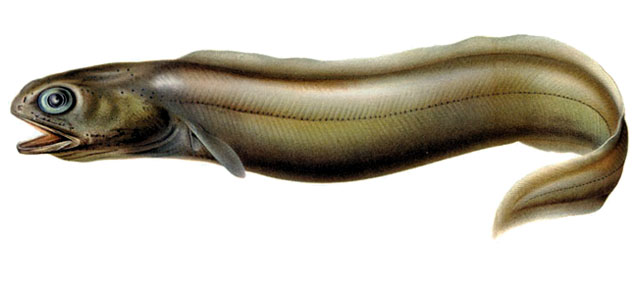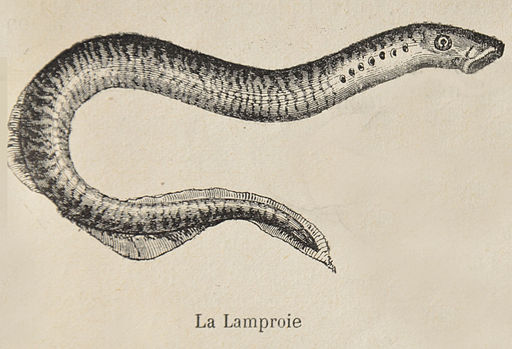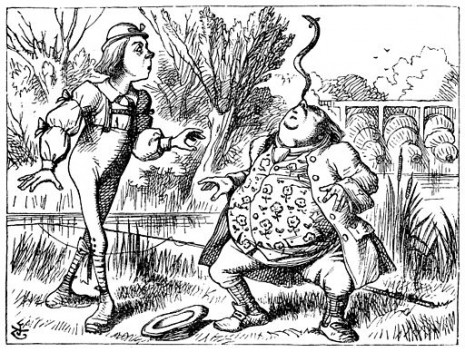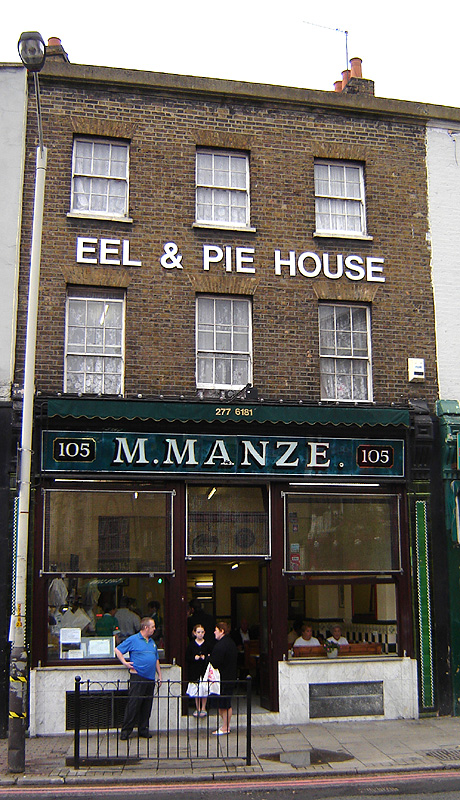The world’s biggest urban population in the year AD 1000 was Cordova, Spain (estimated at about half a million people).
Character Reference
The word “quixotic,” meaning “foolishly impractical,” entered the English language from the name of Cervantes’ main character, Don Quixote.
Slithery Slope
 One warm spring day back when I was about fourteen, I was casually dandling my fishing line into the shallow water on a bank of Lake Champlain. I was with my older sister and her friend, who were off kayaking around the corner, when my rod bent almost double and I was very nearly dragged into the water. A huge, brown, undulating creature rose to the surface. It was probably four feet long. I’m not a squeamish person, but I admit to having yelled in surprise.
One warm spring day back when I was about fourteen, I was casually dandling my fishing line into the shallow water on a bank of Lake Champlain. I was with my older sister and her friend, who were off kayaking around the corner, when my rod bent almost double and I was very nearly dragged into the water. A huge, brown, undulating creature rose to the surface. It was probably four feet long. I’m not a squeamish person, but I admit to having yelled in surprise.
The creature on the end of my line was an eel, and it had an unnerving, leering expression on its ugly face. The thing was strong. I called to my sister for help and she and her friend came paddling back around the bend to see what the problem was. As soon as they saw the slimy brown slithering thing, they both screamed and paddled away as fast as they could. (Nice.) Then my line snapped, and the creature swam away. Today I feel guilty for having hooked it, as eels in Lake Champlain are endangered.
Lampreys, on the other hand, are an aggressive, invasive species that prey on indigenous fish populations. They’re closely related to eels. Here’s a charming picture of an enormous lamprey caught in New Jersey a few days ago. A lamprey feeds on its prey by latching onto it with its huge, sucking mouthpart. Then it sweeps its barbed tongue back and forth across the victim’s flesh to open a wound, while spitting out some anticoagulants. And then it sucks its victim’s blood.
I’m never going swimming again.
 According to Cassius Dio and also Seneca the younger (ON ANGER, III. xi. 2-xli. 2 ) the notoriously cruel Roman equestrian Vedius Pollio (who died 15 BC) kept a pool of huge lampreys trained to eat men (shudder). Once when Pollio was entertaining the emperor Augustus, a slave boy broke a crystal goblet. Pollio ordered the boy tossed to the lampreys. The slave fell on his knees and begged Augustus to die some other way. Augustus was so horrified he ordered all the rest of the cups broken and the pool filled in.
According to Cassius Dio and also Seneca the younger (ON ANGER, III. xi. 2-xli. 2 ) the notoriously cruel Roman equestrian Vedius Pollio (who died 15 BC) kept a pool of huge lampreys trained to eat men (shudder). Once when Pollio was entertaining the emperor Augustus, a slave boy broke a crystal goblet. Pollio ordered the boy tossed to the lampreys. The slave fell on his knees and begged Augustus to die some other way. Augustus was so horrified he ordered all the rest of the cups broken and the pool filled in.
Eels and lampreys have been an inexpensive protein source since medieval times. In 1135, Henry I (youngest son of William the Conqueror) died after eating “a surfeit of lampreys.”

The fifteenth century author and cookery book writer Platina (1421-1481) gives us a recipe for eels in a torta, (translated by Elizabeth Buermann Andrews). I love the last line of the recipe:
Eels in a Torta – To boiled eels that have been cut into bits, add either milk from other fish or finely chopped soft fat. Cut up a little mint and parsley. Add an ounce of pine kernels, a like amount of raisins, a little cinnamon, ginger, pepper, clove, and mix. Then spread it into your crust. You should add a little best oil. When it is nearly cooked, dissolve two ounces of ground almonds in verjuice with saffron and pass through a strainer and gently spread this over the whole top. Palladius Rutilius is marvellously fond of this dish, even though it is not good.
(Source: author Linda Stradley, from her web site What’s Cooking America)
Eels soared in popularity in London during the nineteenth century, as they were the only aquatic creatures able to survive the intensely polluted waters of the Thames River. By midcentury the Thames had become a reeking cesspool for its three million plus occupants. (You can read about the “Big Stink” of 1858 in my Poop book.) This polluted water was piped back out and into standpipes around the city, untreated and unfiltered, for people to use as drinking water. On several occasions, live eels squiggled out of peoples’ faucets.
Jellied eels and eel pies are still very popular in parts of England.

Images
Brauer, Coloconger raniceps, 1863 via Wikimedia Commons
Reproduction of an old engraving (anonymous) used as illustration in an article about lamprey (1912)
Sir John Tenniel (“Alice’s Adventures in Wonderland” (1865)) [Public domain], via Wikimedia Commons
Manze’s Eel and Pie House, Peckham, Southwark, London. 29 October 2005. Photographer: Fin Fahey via Wikimedia Commons
The Twain Did Meet
For their first date, Samuel Clemens (aka Mark Twain) and his future wife, Olivia Langdon, went to hear Charles Dickens speak.
Ready, Aim, Fire, Take a Nap
Sixteenth century naval cannons, such as were used in the battle between the English and the Spanish in 1588, were notoriously difficult to load, aim, fire, and reload. A well-trained gun crew could do it in under two minutes. Some Spanish guns took an hour to cool before they could be reloaded. Several exploded anyway, killing their crew.
You Give Me Fever
To avoid contamination during the yellow fever epidemic of 1793, people in Philadelphia stopped shaking hands and walked down the middle of the street.
(David McCullough, John Adams, p 446)
Posthumous Poetry
The vast majority of Emily Dickinson’s poems were not published until after her death. At her funeral, a poem by Emily Bronte was read.
Rock Solid
 As you may have read, Siberians are rushing out to look for bits of the meteor that exploded there a week ago Friday, in hopes of selling them for a lot of money. (I blogged about that meteor, as well as the one from 1908, here.)
As you may have read, Siberians are rushing out to look for bits of the meteor that exploded there a week ago Friday, in hopes of selling them for a lot of money. (I blogged about that meteor, as well as the one from 1908, here.)
The heaviest meteorite ever moved by humans is now sitting on the ground floor of the American Museum of Natural History. The 34 ton iron rock is so heavy, it has to stand on supports that reach all the way into the bedrock below the museum. It’s called the “Ahnighito”, or the “Cape York Meteorite,” and it was sold to the museum by none other than the famous Arctic explorer, Robert E. Peary.
He excavated three stones from Savissivik, Greenland, after coaxing the local Inuits to show him where to find them. (It took some doing to convince them. In his account, he calls them “Eskimos” and, elsewhere, “a little family of Arctic aborigines.” Shudder.) You can read his firsthand account of that expedition here. You can also read a previous post of mine about Peary and Henson and what the Inuits taught them about Arctic-wear here.
One of the meteorites weighed about 5,500 pounds, another about 1100 pounds. These he arranged to have excavated and moved using hydraulic jacks to dislodge them, then ferried across water on a seven foot thick ice raft.
But removing the monster, the Ahnighito, was a different story. It had collided with the Earth 10,000 years ago. For centuries, the Inuit had chipped off pieces of iron from all the meteorites for metal tools and harpoons.
Peary enlisted “all the able-bodied men of the village” to work for him excavating and transporting the monster onto his ship. I’m pretty sure he didn’t give them any money. But he did pay them with “guns, knives, ammunition, and other articles which I had brought to reward them for their faithful service.” What’s not clear in his account is how the Inuits felt about having their sources of iron removed. Peary sold the meteorites to the American Museum of Natural History for $40,000.
How did they move a 34 ton iron rock? They dislodged it with massive hydraulic jacks. Then they laboriously moved it on rails, rolled it down a hill, and built more rails to get it to water’s edge. It took a few tries–he had to abandon the rock near the water’s edge, for fear of his ship being damaged, returning the following spring.
 They needed a big ship. To get it on board . . . well, here’s Peary’s description. You don’t have to read it too closely. If you just scan it, you’ll get the idea. (But if you want to read his account in full, you can do so here.)
They needed a big ship. To get it on board . . . well, here’s Peary’s description. You don’t have to read it too closely. If you just scan it, you’ll get the idea. (But if you want to read his account in full, you can do so here.)
He keeps going, but you get the idea. Once on board the ship, the iron rock made the ship’s compasses go haywire. But they arrived safely at New York–here are more pictures, courtesy of the digital history project website.


By Mike Cassano (Ahnighito meteorite) via Wikimedia Commons
“Raising the meteorite from the hold,” http://www.digitalhistoryproject.com/2011/07/saviksue-lieutenant-robert-e-peary.html
“The great meteorite being swung on to the wharf,” http://www.digitalhistoryproject.com/2011/07/saviksue-lieutenant-robert-e-peary.html
“The meteorite covered and placed under guard at the wharf,” http://www.digitalhistoryproject.com/2011/07/saviksue-lieutenant-robert-e-peary.html
Wonder Drug
In 1895, a scientist at the Bayer Company discovered that diluting morphine with acetyls produced a drug without the common morphine side effects. Bayer began producing this new drug, which it called “heroin.”
Royal Pain in the Butt
King Louis XIV (1638 –1715) was at the height of his reign when, in 1685, his butt started to hurt. A lot. His royal physicians tried all kinds of treatments, endeavoring to shrink the swelling, but finally, after months of suffering on everyone’s part, they called for a surgeon. This was a big deal.
Surgeons at the time were not considered respectable. They were many notches below physicians, on the level of barbers (in fact, most were barbers). The Church forbade doctors to cut into a living body. But the king and his physicians were desperate.
(On a side note—1685 was the year that Louis revoked the Edict of Nantes, resulting in the killing or defection of hundreds of thousands of Huguenots. One wonders if the king’s lack of tolerance may have been caused in part by the fact that he couldn’t sit down comfortably.)
His butt problem was diagnosed as an anal fistula. I’m not going to explain what an anal fistula is. Admittedly, it takes a lot to gross me out, but even I have my limits. Let your imagination run wild. The real thing is probably worse than what you’re imagining. (Or you can read about the condition here. Fair warning. This site comes with pictures.) I’m also not going to conjecture about how the king developed said fistula. Suffice to say, his hygiene was not good. He often ordered windows to be opened when he entered a room, so that his courtiers would not be overcome by his smell.
The surgeon, Charles Francois Félix de Tassy, requested to wait six months before operating. The guy was flipping out. He practiced on a bunch of peasants, none of whom actually had anal fistulae, and some of whom died, before he felt he was ready to operate on the king.
The king’s fistula operation was performed on November 18th 1686. Sources reported that the king was calm. The surgeon was not. Félix had designed a “royally curved” scalpel especially for that purpose, inserting it into the fistula with the help of a retractor. To see these scary instruments, click on this site.
The operation was a success. The king was sitting up in bed within a month. It became fashionable for courtiers to admit they had a fistula, too, in hopes of being able to walk around Versailles with their butts swaddled like the king’s.
Why is this story important? By operating successfully on the king, Félix raised the profession of surgery to a more prestigious level. Félix was knighted and given money and land. But he was said to be so traumatized that he never again touched a scalpel.
Here’s le roi, back in the saddle: